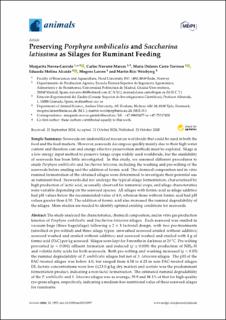| dc.contributor.author | Novoa-Garrido, Margarita | |
| dc.contributor.author | Navarro Marcos, Carlos | |
| dc.contributor.author | Travieso Carro, Maria Dolores | |
| dc.contributor.author | Molina-Alcaide, Eduarda | |
| dc.contributor.author | Larsen, Mogens | |
| dc.contributor.author | Riis Weisbjerg, Martin | |
| dc.date.accessioned | 2021-02-17T14:42:02Z | |
| dc.date.available | 2021-02-17T14:42:02Z | |
| dc.date.created | 2020-10-23T15:48:39Z | |
| dc.date.issued | 2020 | |
| dc.identifier.citation | Novoa-Garrido, M., Marcos, C. N., Travieso, M. D. C., Alcaide, E. M., Larsen, M. & Weisbjerg, M. R. (2020). Preserving Porphyra umbilicalis and Saccharina latissima as silages for ruminant feeding. Animals, 10(11): 1957. doi: | en_US |
| dc.identifier.issn | 2076-2615 | |
| dc.identifier.uri | https://hdl.handle.net/11250/2728740 | |
| dc.description.abstract | The study analyzed the characteristics, chemical composition, and in vitro gas production kinetics of Porphyra umbilicalis and Saccharina latissima silages. Each seaweed was ensiled in vacuum bags (three bags/silage) following a 2 × 3 factorial design, with two pre-treatments (unwilted or pre-wilted) and three silage types: unwashed seaweed ensiled without additive; seaweed washed and ensiled without additive; and seaweed washed and ensiled with 4 g of formic acid (FAC) per kg seaweed. Silages were kept for 3 months in darkness at 20 °C. Pre-wilting prevented (p < 0.001) effluent formation and reduced (p ≤ 0.038) the production of NH3-N and volatile fatty acids for both seaweeds. Both pre-wilting and washing increased (p < 0.05) the ruminal degradability of P. umbilicalis silages but not of S. latissima silages. The pH of the FAC-treated silages was below 4.0, but ranged from 4.54 to 6.23 in non FAC-treated silages. DL-lactate concentrations were low (≤23.0 g/kg dry matter) and acetate was the predominant fermentation product, indicating a non-lactic fermentation. The estimated ruminal degradability of the P. umbilicalis and S. latissima silages was as average, 59.9 and 86.1% of that for high-quality rye-grass silages, respectively, indicating a medium-low nutritional value of these seaweed silages for ruminants. | en_US |
| dc.language.iso | eng | en_US |
| dc.publisher | MDPI | en_US |
| dc.rights | Navngivelse 4.0 Internasjonal | * |
| dc.rights.uri | http://creativecommons.org/licenses/by/4.0/deed.no | * |
| dc.subject | Tang og tare | en_US |
| dc.subject | Seaweeds | en_US |
| dc.subject | Husdyrproduksjon | en_US |
| dc.subject | Animal Science | en_US |
| dc.subject | Blå grønne løsninger | en_US |
| dc.subject | Blue green solutions | en_US |
| dc.title | Preserving Porphyra umbilicalis and Saccharina latissima as Silages for Ruminant Feeding | en_US |
| dc.type | Peer reviewed | en_US |
| dc.type | Journal article | en_US |
| dc.description.version | publishedVersion | en_US |
| dc.rights.holder | © 2020 The Author(s) | en_US |
| dc.subject.nsi | VDP::Landbruks- og Fiskerifag: 900::Landbruksfag: 910 | en_US |
| dc.source.pagenumber | 18 | en_US |
| dc.source.volume | 10 | en_US |
| dc.source.journal | Animals | en_US |
| dc.source.issue | 11 | en_US |
| dc.identifier.doi | 10.3390/ani10111957 | |
| dc.identifier.cristin | 1841853 | |
| dc.relation.project | Norwegian Regional Research Fund-North: 248210 | en_US |
| dc.source.articlenumber | 1957 | en_US |

